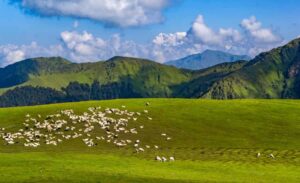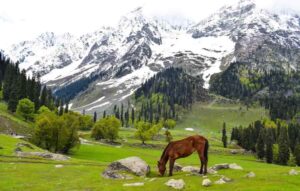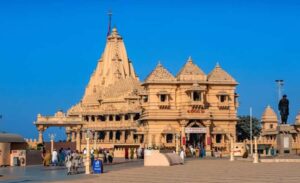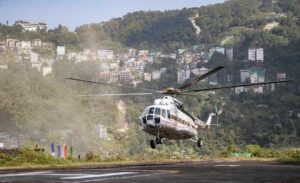Best Time To Visit Leh
Leh, the capital of Ladakh in northern India, is a destination that captivates travelers with its surreal landscapes, pristine beauty, and rich cultural heritage. Situated at a high altitude in the Himalayan region, Leh experiences extreme weather conditions throughout the year. Choosing the right time to visit Leh is crucial for a memorable and safe experience. In this comprehensive guide, we will explore the best times to visit Leh, discussing the weather, temperature, and the unique attractions each season has to offer.

Spring (March to May)
Weather
Spring in Leh is a time of transformation as the region shakes off its winter slumber. The temperatures start to rise, and the days become longer. However, it’s still quite cold, especially in March, with daytime temperatures ranging from 6°C to 15°C. As spring progresses, the weather becomes more pleasant, with temperatures between 15°C to 20°C in May.
Pros
- The melting snow creates a lush landscape with blooming flowers, making it an ideal time for nature enthusiasts and photographers.
- The weather is relatively mild, making it perfect for outdoor activities like trekking and biking.
- It’s a less crowded season compared to summer, so you can enjoy a more peaceful experience.
Cons
- High mountain passes and some attractions may still be closed due to lingering snow.
- The nights can be chilly, so warm clothing is essential.
Key Attractions
- Shey Palace and Monastery
- Thiksey Monastery
- Stok Palace
- The famous Shanti Stupa
- Outdoor activities like trekking, mountain biking, and river rafting.
Summer (June to August)
Weather
Summer is the peak tourist season in Leh. The temperatures range from 20°C to 30°C during the day, making it the warmest time to visit. The nights are pleasantly cool, with temperatures dropping to around 10°C. June is the best time to visit if you prefer cooler weather, while August can be warmer.
Pros
- Most of the high mountain passes and trekking trails are open during this time.
- Leh experiences longer daylight hours, allowing for more activities and exploration.
- The region is at its most vibrant, with lush greenery and vibrant landscapes.
Cons
- It can get crowded, especially in July and August, so plan your accommodations and activities in advance.
- The summer months also coincide with the monsoon season, so occasional rain showers may disrupt outdoor plans.
Key Attractions
- Nubra Valley
- Pangong Lake
- Tso Moriri Lake
- Leh Palace
- Hemis Monastery
- Monastery festivals (Hemis Festival in June)
Monsoon (September to October)
Weather
The monsoon season in Leh is relatively short, beginning in September and tapering off in October. During this time, the daytime temperatures range from 15°C to 25°C, and the nights start to become colder. While Leh is generally dry, occasional rainfall can occur during the monsoon season.
Pros
- The landscape is incredibly green and lush, offering a unique and picturesque backdrop for your journey.
- Fewer tourists visit during this period, so you can enjoy the serene beauty of the region in relative peace.
Cons
- The monsoon season can bring unpredictable weather, including occasional rainfall and cloudy skies.
- Some remote areas may still be inaccessible due to road closures caused by landslides.
Key Attractions
- Alchi Monastery
- Basgo Monastery
- Exploring the vibrant, green landscapes of the region
- Trekking and camping in the Zanskar Valley
Autumn (November to December)
Weather
Autumn is when Leh experiences a drastic drop in temperature, with daytime highs ranging from 0°C to 15°C and nighttime temperatures plummeting below freezing. The landscape starts to lose its greenery and take on a more barren appearance.
Pros
- Leh becomes less crowded, offering a more intimate and peaceful experience.
- The clear skies provide excellent visibility for stargazing and photography.
- This is the best time for those seeking a unique winter adventure and experiencing the region’s true wilderness.
Cons
- Many accommodations and restaurants start to close for the winter season.
- Some of the higher-altitude passes and trekking routes may close due to snowfall, limiting outdoor activities.
Key Attractions
- Diskit Monastery
- Winter festivals in Leh (if visiting in December)
- Enjoying the serene, snow-covered landscapes
- Visiting local markets for unique winter crafts and souvenirs
Winter (January to February)
Weather
Leh in winter is an extreme and challenging destination. Daytime temperatures rarely rise above freezing, and nights are bitterly cold, often dipping below -10°C. The region remains covered in snow, and many places are inaccessible due to road closures.
Pros
- It’s a unique opportunity to experience Leh in its most extreme and pristine state.
- The sparse tourist presence allows for a truly authentic experience of Ladakhi culture.
Cons
- Extreme cold, heavy snowfall, and road closures can limit your movement and activities.
- Many hotels and guesthouses close during this period, and availability is limited.
Key Attractions
- Chadar Trek (frozen Zanskar River trek)
- Experiencing local festivals and celebrations, especially Losar (Ladakhi New Year)
- Photographing the stunning winter landscapes
Conclusion
Leh, with its stunning landscapes and rich cultural heritage, is a year-round destination that offers a unique experience in every season. The best time to visit depends on your preferences and the kind of experience you seek. Whether you choose the vibrant summer, the colorful autumn, or the extreme beauty of winter, Leh will leave you with memories that last a lifetime. Be sure to plan your trip carefully, considering the weather, temperature, and seasonal attractions, to make the most of your visit to this Himalayan wonderland.
Must Read:





